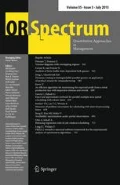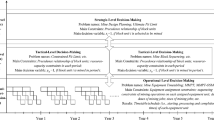Abstract
In this paper, a scheduling problem that occurs in potash mining is introduced, where a block excavation sequence has to be found taking into account a limited number of underground machines as well as safety-related restrictions. The aim is to minimize the maximum completion time of excavations, i.e., the makespan. The resulting problem can be transformed into a hybrid flow shop scheduling problem with reentry, unrelated machines, and job-precedences. A mixed-integer linear model is presented and small-scale instances are solved with CPLEX. In order to tackle medium- and large-scale instances heuristically, a basic and an advanced multi-start algorithm are developed, based on a specific priority rule-based construction procedure. In addition, a modified version of the Giffler and Thompson procedure is applied. Computational experiments are conducted on problem instances derived from real-world data in order to evaluate the performances of the proposed solution procedures.









Similar content being viewed by others
References
Baker KR (1974) Introduction to sequencing and scheduling. Wiley, New York
Baykasoǧlu A, Hamzadayi A, Yelkenci Köse S (2014) Testing the performance of teaching–learning based optimization (TLBO) algorithm on combinatorial problems: Flow shop and job shop scheduling cases. Inf Sci 276:204–218
Beaulieu M, Gamache M (2006) An enumeration algorithm for solving the fleet management problem in underground mines. Comput Oper Res 33:1606–1624
Bedworth DD, Bailey JE (1982) Integrated production and control systems: management, analysis, and design. Wiley, New York
Botta-Genoulaz V (2000) Hybrid flow shop scheduling with precedence constraints and time lags to minimize maximum lateness. Int J Prod Econ 64:101–111
Carlyle W, Eaves B (2001) Underground planning at stillwater mining company. Interfaces 31:50–60
Chen L, Bostel N, Dejax P, Cai J, Xi L (2007) A tabu search algorithm for the integrated scheduling problem of container handling systems in a maritime terminal. Eur J Oper Res 181:40–58
Chen L, Xi L-F, Cai J-G, Bostel N, Dejax P (2006) An integrated approach for modeling and solving the scheduling problem of container handling systems. J Zhejiang Univ Sci A 7:234–239
Chen Y-Y, Cheng C-Y, Wang L-C, Chen T-L (2013) A hybrid approach based on the variable neighborhood search and particle swarm optimization for parallel machine scheduling problems - a case study for solar cell industry. Int J Prod Econ 141:66–78
Chesworth W (2008) Encyclopedia of soil science. Springer, Dordrecht
Cho H-M, Bae S-J, Kim J, Jeong I-J (2011) Bi-objective scheduling for reentrant hybrid flow shop using pareto genetic algorithm. Comput Ind Eng 61:529–541
Choi H-S, Kim J-S, Lee D-H (2011) Real-time scheduling for reentrant hybrid flow shops: a decision tree based mechanism and its application to a TFT-LCD line. Exp Syst Appl 38:3514–3521
Choi S-W, Kim Y-D, Lee G-C (2005) Minimizing total tardiness of orders with reentrant lots in a hybrid flowshop. Int J Prod Res 43:2149–2167
Epstein R, Goic M, Weintraub A, Catalan J, Santibanez P, Urrutia R, Cancino R, Gaete S, Aguayo A, Caro F (2012) Optimizing long-term production plans in underground and open-pit copper mines. Oper Res 60:4–17
Fereidoonian F, Mirzazadeh A (2011) A genetic algorithm for the integrated scheduling model of a container-handling system in a maritime terminal. J Eng Marit Environ 226:62–77
Gamache M, Grimard R, Cohen P (2005) A shortest-path algorithm for solving the fleet management problem in underground mines. Eur J Oper Res 166:497–506
Giffler B, Thompson GL (1960) Algorithms for solving production-scheduling problems. Oper Res 8:487–503
Grabowski J, Pempera J (2000) Sequencing of jobs in some production system. Eur J Oper Res 125:535–550
Gupta JND (1988) Two-stage, hybrid flow shop scheduling problem. J Oper Res Soc 39:359–364
Hamrin H (2001) Underground mining methods and applications. In: Hustrulid WA, Bullock RL (eds) Underground mining methods: engineering fundamentals and international case studies. SME, Littleton, pp 3–14
Haupt R (1989) A survey of priority rule-based scheduling. OR Spektrum 11:3–16
Hidri L, Haouari M (2011) Bounding strategies for the hybrid flow shop scheduling problem. Appl Math Comput 217:8248–8263
Jin ZH, Ohno K, Ito T, Elmaghraby SE (2002) Scheduling hybrid flowshops in printed circuit board assembly lines. Prod Oper Manag 11:216–230
Kelley JE (1963) The critical-path method: resources planning and scheduling. In: Muth JF, Thompson GL (eds) Industrial scheduling. Prentice-Hall, New Jersey, pp 347–365
Kolisch R (1996) Serial and parallel resource-constrained project scheduling methods revisited: theory and computation. Eur J Oper Res 90:320–333
Kreutz M, Hanke D, Gehlen S (2000) Solving extended hybrid-flow-shop problems using active schedule generation and genetic algorithms. In: Schoenauer M, Deb K, Rudolph G, Yao X, Lutton E, Merelo J, Schwefel H-P (eds) Parallel problem solving from nature PPSN VI, Lecture notes in computer science, vol 1917. Springer, Berlin, pp 293–302
K+S AG (2015) A day in the mine. http://www.k-plus-s.com
Lee G-C (2009) Estimating order lead times in hybrid flowshops with different scheduling rules. Comput Ind Eng 56:1668–1674
Li Z-T, Chen Q-X, Mao N, Wang X, Liu J (2013) Scheduling rules for two-stage flexible flow shop scheduling problem subject to tail group constraint. Int J Prod Econ 146:667–678
Lin H-T, Liao C-J (2003) A case study in a two-stage hybrid flow shop with setup time and dedicated machines. Int J Prod Econ 86:133–143
Martinez MA, Newman AM (2011) A solution approach for optimizing long- and short-term production scheduling at LKAB’s Kiruna mine. Eur J Oper Res 211:184–197
Michalewicz Z, Fogel D (2004) How to solve it: modern heuristics. Springer, Berlin
Nehring M, Topal E, Kizil M, Knights P (2012) Integrated short- and medium-term underground mine production scheduling. J S Afr Inst Min Metall 112:365–378
Nehring M, Topal E, Knights P (2010a) Dynamic short term production scheduling and machine allocation in underground mining using mathematical programming. Trans Inst Min Metall Sect A Min Technol 119:212–220
Nehring M, Topal E, Little J (2010b) A new mathematical programming model for production schedule optimization in underground mining operations. J S Afr Inst Min Metall 110:437–446
Newman AM, Kuchta M (2007) Using aggregation to optimize long-term planning at an underground mine. Eur J Oper Res 176:1205–1218
Newman AM, Rubio E, Caro R, Weintraub A, Eurek K (2010) A review of operations research in mine planning. Interfaces 40:222–245
O’Sullivan D, Newman A (2015) Optimization-based heuristics for underground mine scheduling. Eur J Oper Res 241:248–259
Panwalkar SS, Iskander W (1977) A survey of scheduling rules. Oper Res 25:45–61
Pinedo ML (2008) Scheduling: theory, algorithms, and systems, 3rd edn. Springer, New York
Rahal DC, Smith ML, van Hout G, von Johannides A (2003) The use of mixed integer linear programming for long-term scheduling in block caving mines. In: Camisani-Calzolari FA (ed) Application of computers and operations research in the minerals industries. South African Institute of Mining and Metallurgy, Cape Town, pp 123–131
Ribas I, Leisten R, Frami\(\tilde{\rm n}\)an JM (2010) Review and classification of hybrid flow shop scheduling problems from a production system and a solutions procedure perspective. Comput Oper Res 37:1439–1454
Rossi A, Soldani S, Lanzetta M (2015) Hybrid stage shop scheduling. Exp Syst Appl 42:4105–4119
Ruiz R, Şerifoǧlu FS, Urlings T (2008) Modeling realistic hybrid flexible flowshop scheduling problems. Comput Oper Res 35:1151–1175
Ruiz R, Maroto C (2006) A genetic algorithm for hybrid flowshops with sequence dependent setup times and machine eligibility. Eur J Oper Res 169:781–800
Ruiz R, Vázquez-Rodríguez JA (2010) The hybrid flow shop scheduling problem. Eur J Oper Res 205(1):1–18
Saayman P, Craig IK, Camisani-Calzolari FR (2006) Optimization of an autonomous vehicle dispatch system in an underground mine. J S Afr Inst Min Metall 106:77–86
Santos DL, Hunsucker JL, Deal DE (1995) Global lower bounds for flow shops with multiple processors. Eur J Oper Res 80:112–120
Sarin S, West-Hansen J (2005) The long-term mine production scheduling problem. IIE Trans 37:109–121
Simsir F, Ozfirat MK (2008) Determination of the most effective longwall equipment combination in longwall top coal caving (LTCC) method by simulation modelling. Int J Rock Mech Min Sci 45:1015–1023
USGS (2011) Metals and minerals: united states geological survey minerals yearbook. United States Government Printing Office, Washington
Voß S, Witt A (2007) Hybrid flow shop scheduling as a multi-mode multi-project scheduling problem with batching requirements: A real-world application. Int J Prod Econ 105:445–458
Weintraub A, Romero C, Bjørndal T, Epstein R (2007) Handbook of operations research in natural resources. In: International series in operations research & management science, vol. 99. Springer, New York
Xu Y, Wang L (2011) Differential evolution algorithm for hybrid flow-shop scheduling problems. J Syst Eng Electron 22:794–798
Yaurima V, Burtseva L, Tchernykh A (2009) Hybrid flowshop with unrelated machines, sequence-dependent setup time, availability constraints and limited buffers. Comput Ind Eng 56:1452–1463
Acknowledgments
The benchmarks presented herein may be downloaded from http://www.wiwi.tu-clausthal.de/abteilungen/unternehmensforschung/forschung/benchmark-instances/.
Author information
Authors and Affiliations
Corresponding author
Rights and permissions
About this article
Cite this article
Schulze, M., Rieck, J., Seifi, C. et al. Machine scheduling in underground mining: an application in the potash industry. OR Spectrum 38, 365–403 (2016). https://doi.org/10.1007/s00291-015-0414-y
Received:
Accepted:
Published:
Issue Date:
DOI: https://doi.org/10.1007/s00291-015-0414-y




